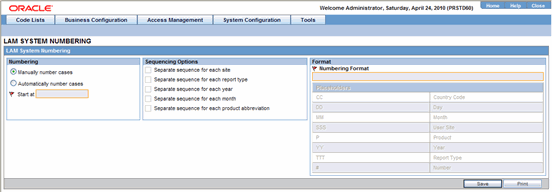Configuring the Oracle Argus Affiliate System Numbering
The system provides the ability to use multiple case numbering schemes for globally. For example, if site is used in the numbering, the system provides the option to keep separate sequences for each site. However, Oracle Argus Affiliate System Numbering configuration can only be done from Oracle Argus Safety application. Therefore, to configure the Oracle Argus Affiliate System Numbering, the Administrator must be logged on to Oracle Argus Safety application, and the System Numbering menu and the Local Affiliate sub-menu must be enabled in the User Group.
Select Argus Console > System Configuration > System Numbering > Local Affiliate to view the Oracle Argus Affiliate System Numbering screen. The following is an illustration of the LAM System Numbering page.

The following table lists and describes the fields on the LAM System Numbering page.
| Field | Description |
|---|---|
|
Manually Number Cases |
The option enables the user to manually number the cases on booking or while copying the case, using the "save as" option on the case form. |
|
Automatically Number Cases |
On selection, the system automatically numbers the cases as defined by the user in the numbering format. |
|
Start at |
Enables the user to initialize the counter of the sequence number. |
|
Separate sequence for each site |
Enables the user to separate the sequence numbering for cases on site by site basis. If there are cases being entered from two different sites then each site will have different sequencing of case numbers. |
|
Separate sequence for each report type |
Enables the user to separate the sequence numbering for cases by the report type of the case. |
|
Separate sequence for each year |
Enables the user to reset the sequence numbering for cases after each year, based on the initial receipt date of the case. |
|
Separate sequence for each month |
Enables the user to reset the sequence numbering for cases after each month, based on the initial receipt date of the case. |
|
Separate sequence for each product abbreviation |
Enables the user to reset the sequence numbering for cases for each different product abbreviation. |
|
Numbering Format |
Enables the user to select the numbering format by selecting the different placeholders. Define the numbering format by typing in custom keywords to print on every case number & selecting different placeholders. [YY][MM]-[###] is the default format. |
|
Placeholder |
Enables the user to enter a placeholder. Placeholders are used to pickup values from the database to be used in the Case numbering format. The possible values populated in this list are:
|
To Configure Oracle Argus Affiliate system numbering:
Parent topic: Creating User Accounts